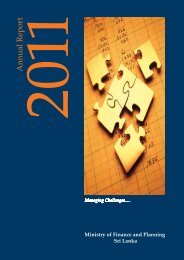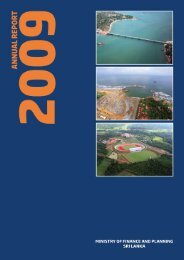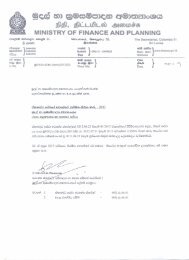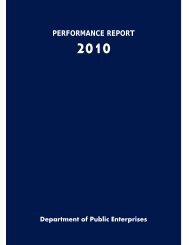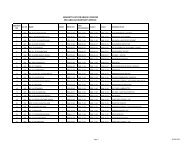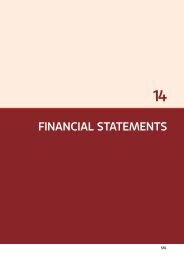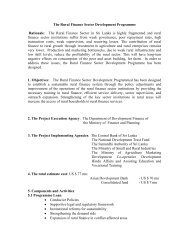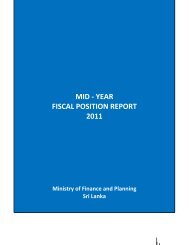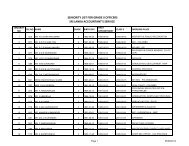Annual Report 2010 - Ministry of Finance and Planning
Annual Report 2010 - Ministry of Finance and Planning
Annual Report 2010 - Ministry of Finance and Planning
Create successful ePaper yourself
Turn your PDF publications into a flip-book with our unique Google optimized e-Paper software.
<strong>Ministry</strong> <strong>of</strong> <strong>Finance</strong> <strong>and</strong> <strong>Planning</strong> Sri Lanka > <strong>Annual</strong> <strong>Report</strong> <strong>2010</strong>the Health Services Officer. The programme will beimplemented in three phases i.e. (i) agriculture, (ii)industries <strong>and</strong> (iii) fisheries <strong>and</strong> livestock. The householdswill be given the option <strong>of</strong> deciding a particular phasethat they wish to be engaged in the programme.to the implementation problems faced by the peoplehas also been launched by the <strong>Ministry</strong> <strong>of</strong> EconomicDevelopment, the implementing body <strong>of</strong> the programme.About 20 other ministries will also be involved assupporting partners in implementing this programme.The programme initially commenced with the Phase I, i.e.Agriculture, considering the strong need for cultivatingfruits <strong>and</strong> vegetables. Accordingly, a “Divi Neguma”recipient can select various types <strong>of</strong> seeds for cultivationdepending on his area <strong>of</strong> residency; 12 types for lowcountry, 6 types for wet zone <strong>and</strong> 3 types for up country.The government will also provide technical <strong>and</strong> otherassistance to initiate scientific cultivation at a small scalewith organic agriculture being emphasized. The second<strong>and</strong> third phases will be commenced with a time lag.A programme to supervise the implementation <strong>of</strong> the DiviNeguma programme, provide advice <strong>and</strong> find solutionsIn the context <strong>of</strong> meeting the objectives <strong>of</strong> thisinnovation, the Divi Neguma programme is based onthe concept “People Initiate; Government Facilitate”thus limiting the role <strong>of</strong> government in home economydevelopment programme.Therefore, the success <strong>of</strong> this programme will depend onthe partnership between the people <strong>and</strong> the government.The successful completion <strong>of</strong> this programme will leadto create an international example <strong>of</strong> dealing with foodcrises effectively in the midst <strong>of</strong> climate change <strong>and</strong> otheradversaries that affect the global food security.LivestockThe livestock sector is an integral part<strong>of</strong> the agricultural economy <strong>of</strong> Sri Lanka<strong>and</strong> it plays a dominant role in foodsecurity, poverty reduction, livelihooddevelopment <strong>and</strong> reduction <strong>of</strong> undernutrition.The livestock sector whichmainly consists <strong>of</strong> the dairy <strong>and</strong> poultrysub sectors considered as one <strong>of</strong> thehigh priority areas for future growth<strong>and</strong> investment. The contribution <strong>of</strong> thelivestock sector to the national GDP in<strong>2010</strong> was 0.8 percent. The governmentis planing to increase this significantly.The main policy objective <strong>of</strong> thelivestock sector is to achieve a higherlevel <strong>of</strong> self - reliance in milk <strong>and</strong>livestock production which will bemade available to consumers at anaffordable price for improving theirnutrition status <strong>and</strong> tapping sectorpotential in generating employment.The livestock policy encourages theprivate sector to engage in commercialoperations while public sectorinvestment will gradually be directedto regulatory activities, research <strong>and</strong>extension services which are the areaswhere returns on investment are notattractive to the private sector but areessential to the development <strong>of</strong> theindustry.Total milk production in the countryhas been increased by 6 percent to247.5 million litres in <strong>2010</strong> from thelevel <strong>of</strong> 233.3 million litres in 2009This includes 191.9 million litres <strong>of</strong>cow milk <strong>and</strong> 55.6 million litres <strong>of</strong>buffalo milk. In <strong>2010</strong>, 35 percent <strong>of</strong>national requirement was met bythe local production. The averagefarm gate price <strong>of</strong> milk had beenaround Rs.33.20 per litre duringthe year <strong>2010</strong> showing a 10 percentincrease compared with the pricein 2009. Various state supporteddairy development programmesimplemented in the country havecontributed to this growth in thedairy industry (Table 1.38). Import <strong>of</strong>milk <strong>and</strong> milk products at 72,426 MT(CIF value: Rs 27.93 billion) in <strong>2010</strong>indicated an increase <strong>of</strong> 16 percentwhen compared with the volume <strong>of</strong>62,375 MT (CIF value: Rs 18.05 billion)in 2009 reflecting a substantialincrease <strong>of</strong> consumer dem<strong>and</strong>.Poultry meat production hasincreased by 5 percent from the level<strong>of</strong> 99,280 MT in 2009 to 104,160 MTin <strong>2010</strong> mainly due to the importation<strong>of</strong> broiler parent stock <strong>and</strong> prevailinggood health conditions in poultryfarms. The egg production in <strong>2010</strong>showed a slight decrease <strong>of</strong> 0.2percent, from the level <strong>of</strong> 1,142million in 2009. Farm gate price <strong>of</strong>live broiler <strong>and</strong> table eggs recordedhigh prices towards the latterpart <strong>of</strong> the year <strong>and</strong> were in shortsupply during the festive season <strong>of</strong>December <strong>2010</strong>.The cost <strong>of</strong> production <strong>of</strong> chickenmeat <strong>and</strong> eggs has increased dueto the high feed prices, as maizeprices rose due to the shortage<strong>of</strong> supply in 2009 Yala season. Asprices <strong>of</strong> chicken meat <strong>and</strong> eggsincreased substantially <strong>and</strong> aroundten million eggs <strong>and</strong> 500 MT <strong>of</strong>chicken meat were imported by“Lak Sathosa” in December <strong>2010</strong><strong>and</strong> January 2011 to stabilize theprices.Out <strong>of</strong> the total governmentinvestment <strong>of</strong> about Rs. 5.7 billionmade in the Livestock sector during2006-<strong>2010</strong> period, Rs. 3.8 billion hasbeen spent as capital expenditure.In comparison with 2006, capitalexpenditure <strong>of</strong> this sector hasincreased by 56 percent in <strong>2010</strong>. Thefinancing pattern <strong>of</strong> the Livestocksector are shown in the Figure 1.44.<strong>and</strong> table 1.39 respectively.99



